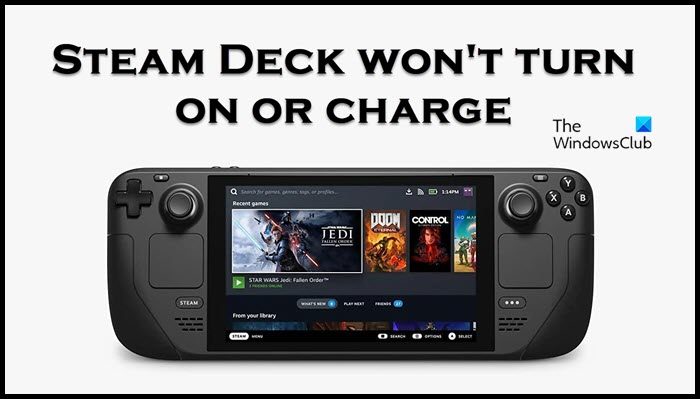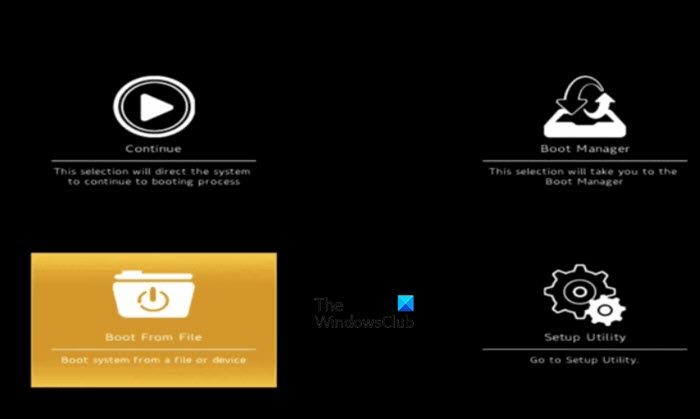Steam Deck allows users to enjoy the latest launched Stream games in a retro handheld device. Its various features have captured many gamers’ hearts. However, it some users have been reporting that Steam Deck is not turning on or charging. In this article, we will see what we can do in such scenarios.

Why won’t my Steam Deck charge or power on?
A device running out of battery or it being low is one of the most common reasons for this cause. So charge the batter for a minimum of 3 hours, and then press the power button and see if it helps or not. In case, if this doesn’t work, check out the solutions mentioned here to resolve the issue.
Fix Steam Deck won’t turn on or charge
If Steam Deck is not charging or turning on, try the solutions prescribed below:
- Check the Power button
- Plug in the deck and inspect the LED next to it
- Force Restart the Steam Deck
- Rollback to the previous SteamOS update
- Manually select the Boot file
- Reinstall the Steam Deck image
- Contact the Steam Deck support
Let’s get this work on the road.
1] Check the Power button
A lot of times, particles and debris get inside the Power button, due to which clicking the button doesn’t work. This should be among the first troubleshooting solutions that users should try to save time. Just use any sharp material, remove the debris, and then try to turn on the Steam Deck. If the issue is caused due to some particle being stuck inside the power button, this solution will do the job.
2] Plug in the deck and inspect the LED next to it
If the Steam deck is suddenly not responding or powering on, then plug in the charger and inspect the LED light. If the LED light is lit, then it is charging properly and will remain the same until the device is fully charged. In case, it’s flashing, plug in your device and leave it for 15 minutes, and then try to start the device. However, if the Steam deck is charging but the power button is not working, then hold the Volume + Button while switching on to boot from the BIOS option.
In case, the device is not charging at all, replace your power adapter and then try. It is very likely that your device is fine and the adapter is at fault. If the adapter is fine, check the port, you can go to your nearest service center after making sure that there are no debris stuck in the port.
3] Force Restart the Steam Deck
If Steam is not turning on from time to time, then try force restarting them and to do so, click and hold the power button for at least 3 seconds and if it does not open, press it for 10 seconds more. Doing so will close the device and once it’s closed, click on the power button to start the Steam Deck. Hopefully, this will help in solving this issue, however, if it persists, see the next solution.
4] Rollback to the previous SteamOS update
A lot of users complained about facing the issue after updating the SteamOS. If you are one such user, roll back the device to the previous SteamOS update, and it will work like a charm. Follow the steps mentioned below to do the same.
- First of all, close the Steam Deck completely.
- Press the Power + Ellipses button and hold it till a click sound is heard.
- Now, release the Power button but hold on to the Ellipses button.
- An array of SteamOS images or some restore points will appear on the screen.
- Select the predecessor to the current version and turn on the device.
Once the Steam Deck boots, your issue will be resolved.
5] Manually select the Boot file

One of the reasons why Steam Deck cannot boot up is its failure to identify the boot file. In such scenarios, you have to manually select the boot file by navigating to the right boot file. Here’s how to do so:
- Click the Volume Up and Power buttons together to open the boot menu.
- You’ll see 4 options on the screen but select the Boot From File option.
- File Explorer screen will appear on the screen, and click on the ESP file from there.
- This will open the EFI folder. Now click on the SteamOS directory, and then on the STEAMCL.EFI file.
Above mentioned steps will force the Steam Deck boot-up system to always recognize the appropriate boot file, and restart the device to the home screen.
Read: Steam Deck vs Nintendo Switch: Which is the better?
6] Reinstall the Steam Deck image
If manually selecting the boot file was not the issue, then try reinstalling the Steam Deck, as issues within the OS can be a cause of this issue. To reinstall the Steam Deck image, follow the steps prescribed below:
- First and foremost, go to store.steampowered.com, and download the Steam Deck Image.
- Now use a USB stick with enough memory, and convert it into a SteamOS bootable disk using Rufus.
- Properly close the Steam Deck and connect the USB Bootable disk to it.
- To access the Boot menu, click the Power on + Volume Up button to access, and select the Boot Manager or you can also press these two buttons until the Boot Manager appears on the screen.
- Click on the EFI USB Device to set the USB stick as the source directory.
- The steam deck will re-install the SteamOS, and once done, you’ll be back to the home screen.
Finally, check if the issue is resolved.
7] Contact the Steam Deck support
Last but not least, if you’ve tried all of the above-mentioned solutions, and have very cheerfully inspected hardware related to Steam Deck, reach out to Steam Deck support. Give them a brief inspection of the situation, and ask them to figure out the issues and their solutions.
We hope you can resolve the issue using the solutions mentioned in this article.
Also Read: How to install Windows 11 on Steam Deck
How do I know if my Steam Deck is charging?
If you are using the Steam Deck for the first time, it needs to be plugged in before usage. And once you plug in the cable, a yellow LED light will continue to illuminate, indicating the charging, and will switch off when the Steam Deck is fully charged.
Leave a Reply